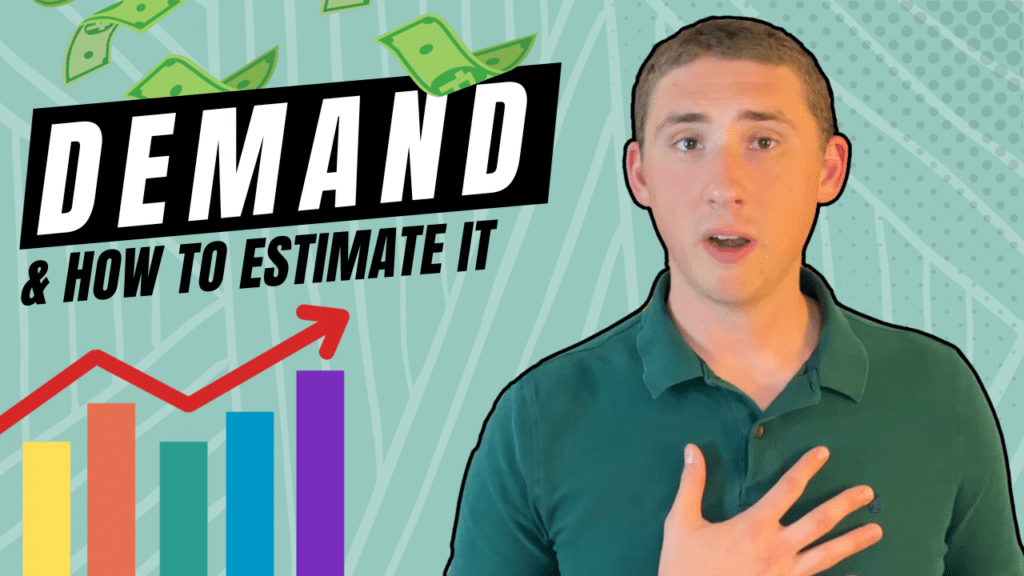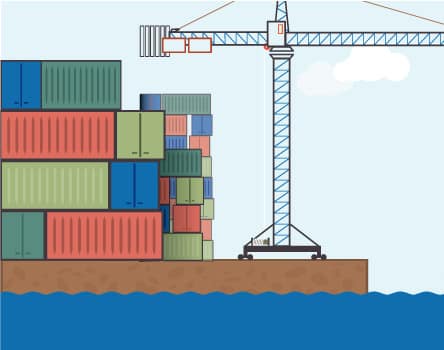“How much am I going to sell?”
Every eCommerce store owner has to ask themselves that at some point. Usually repeatedly.
It’s a big question and it’s not something you can just Google. It’s too complex. There are too many factors.
That’s why in this video, we’re going to talk about how you can estimate eCommerce demand. We’re going to talk about why you need to do this in a rigorous, careful way. Then we’ll discuss four methods you can use to estimate demand. We’ll wrap up by talking about the limitations of demand forecasting so you don’t overextend yourself by mistake.
My name is Brandon, here on behalf of Fulfillrite. If you need help shipping your orders, go to fulfillrite.com and request a quote. We’ve shipped for thousands of clients and we’re happy to help you ship your orders too. The quote doesn’t cost a thing, so if nothing else, you get some good information about pricing. Link in the description.
But enough self-promotion. Let’s talk about…
Why You Should Estimate Demand
Trying to success in eCommerce without estimating demand is a dangerous game. It basically means trying to run a store without considering inventory management.
Here’s the deal – when you can forecast demand, you know roughly how much stock to keep. You won’t be as likely to overstock and you won’t be as likely to run out either. It cuts costs and it keeps customers happy.
Then there’s your marketing budget. Why toss money at promoting a product that’s gathering dust when you could be investing in items that everyone’s scrambling to get? Estimating demand means putting money on winning products.
You can’t really scale without estimating demand either. By understanding which products are gaining traction, you’re equipped to make smarter expansion moves, riding the wave of market trends.
But you need to be careful about how you do this. If you misjudge demand, that will lead to problems. Underestimating can mean missed sales opportunities, while overestimating can lead to cash flow challenges and storage costs for unsold inventory.
So let’s talk about how you can do it right. We’ll discuss four evergreen methods for predicting demand. Starting with…
Method #1: Using Past Sales
When talking inventory, past sales offer real numbers. If you have them, use them.
They tell you which products are year-round winners and which ones are duds or flashes in the pan. With this knowledge, you can align your inventory with expected demand, meaning no excess stock and no last-minute buying frenzies.
This can also help you figure out how to allocate your marketing budget, which, in turn, can help you estimate sales demand.
If one product is consistently outdoing the rest, it’s time to boost its marketing budget and grab a bigger share of your audience. Those that lag behind? Time to rethink their positioning before spending big bucks.
When it comes to business growth, past sales are invaluable. Tracking trends over time can unveil the rising stars in your product lineup. These golden insights pave the way for decisions like launching new products, forging partnerships, or tapping into new markets.
But be careful about relying on past sales alone. New products tend to sell better than older ones and you can also see huge spikes for no obvious reason at all. So if you start with skewed data and end up betting big based on bad numbers, you can tie up funds and flood your storage with unsold goods. Likewise, if you play it too safe due to a couple of slow months? You risk missing out on sales.
In short, while past sales give a ton of insights, they’re part of a bigger picture. If you want a true 360° view, you need to mix past sales data with other demand-predicting techniques such as…
Method #2: Using Ad Spend
Digital ads let you see what your potential customers want. And if used right, they’re a strong predictor of demand.
Every dollar you put into digital ads amplifies your product’s visibility. Spend more, reach more people. And the way these people react—through clicks, interactions, and buys—paints a clear demand picture. Put simply, if you’re pouring money into promoting a product and seeing a lot of engagement, you’re on the right track.
You’ll also want to pay attention to website traffic too. A spike in visitors post-ad campaign isn’t just a number. It’s potential sales. However, high traffic without sales rings alarm bells. It means people are curious, but something’s stopping them from buying.
So, a quick tip: keep a close eye on conversion rates and cart drop-offs. A solid conversion rate means your ads aren’t just pulling people in; they’re making them buy. But if carts are being abandoned more often, maybe it’s time to reassess things like your pricing, shipping costs, or checkout flow.
Once you nail down this method, you can eventually say, with a good degree of confidence, if I spend “X dollars on ads, we’ll see about Y in sales.” That makes demand estimation much easier.
Now sure, it can’t account for sales that don’t originate from ads. And you also have to know that ads tend to be more expensive during the holidays. But digital ads for eCommerce are one of the few places where you can reliably say, “if we spend this, we’ll get that.”
But be careful about making all your decisions via spreadsheets. Sometimes, you need to consider the bigger picture. For that, you’ll want…
Method #3: Using Market Data & Expert Opinions
Past sales and ad spend are useful because they can provide very concrete numbers. But those numbers are based on the idea that things will continue more or less as they already have.
But you need to consider the broader context around you. For that, publicly available market studies and reports can be really useful. They pool data from various corners, giving you a peek into what customers are loving, what’s trending, and what might shake up the market next.
Pay attention to thought leaders in your niche too. They can help you see the broader context. What’s happening on the world stage? Is a fresh tech trend shifting how folks shop? Having a grasp on these big-picture scenarios lets you predict how they might tweak demand for what you’re selling.
You can find this sort of advice in a lot of places. From your own sales staff to trade group reps to social media. Take their qualitative insights and compare it to your more number-driven data.
Dive into eCommerce webinars, online forums and subreddits. Go to the occasional networking event, just to make sure you get out in the world every once in a while.
Bottom line? Your own sales and ad figures are key. But blending them with market trends and expert chatter? That’s when you get the full story.
But there’s one more big group of people you need to ask for more help. And we’ll cover that in…
Method #4: Asking Your Audience
Sometimes the most direct way to gauge demand is simply by asking your audience. After all, they’re the ones making the purchasing decisions.
Starting with surveys: They’re your quick ticket to direct feedback. Curious about a new product’s buzz? Or how a tweak in an existing product will go over with your audience? Put together a simple survey, and you’ll get the lowdown pronto. And thanks to tools like Google Forms or SurveyMonkey, getting these out there’s a breeze.
But what if you need more detailed insights? Enter focus groups. These intimate gatherings allow for deep dives into product perceptions. By engaging directly with a select group of potential customers, you can glean invaluable insights into product preferences, potential pain points, and factors influencing purchasing decisions.
For the big picture, you might want to go for market studies. Sure, they demand more legwork than surveys or focus groups. But the payoff? A much wider view of where your product stands in the overall market.
Your audience has a ton of valuable information. All you need to do is find the right way to ask, and you can learn a lot about how certain business strategies can affect demand.
What Demand Estimation Can’t Do
While demand estimation is undeniably a powerful tool in an ecommerce owner’s arsenal, it’s also essential to recognize its limitations.
You can’t predict the future. Really, that’s what it comes down to.
Markets are weird. Shifts happen, sometimes quickly. Sudden global events like COVID-19 can come out of seemingly nowhere. Brand new tech like generative AI can take the world by storm. And your competitors? You never know when they’re going to launch a new product or have a great sale or even suddenly and inexplicably go bankrupt.
Stuff happens!
So approach demand estimation with humility. Review your estimates regularly and change them as new data becomes available. It’s like the old business aphorism: “all models are wrong, some models are useful.”
The point of demand estimation is to help with inventory control and sales forecasting. That’s undeniably true. But on a deeper level, it’s about asking questions about whether you’re selling the right products to the right people. Going through the motions of demand estimation help you do that.
Estimating demand is hard. It looks like science, but it feels like art. But if you practice, you will eventually get good at it. And that will make it so much easier to succeed in your eCommerce endeavors to come!
My name is Brandon, here on behalf of Fulfillrite. If you need help shipping your orders, go to fulfillrite.com and request a quote. We’ve shipped for thousands of clients and we’re happy to help you ship your orders too. The quote doesn’t cost a thing, so if nothing else, you get some good information about pricing. Link in the description.
If you enjoyed this video, please take a moment to like and subscribe. Don’t forget to slap some postage on that bell so we can express ship new videos to you as soon as they drop. And last but not least, if you have any questions, leave a comment below. I will personally answer as many as I can.
Thanks for watching!





